| x x x x x x x x x x x x x x x x x x x x x x x x x x x x x x x x x x x x x x x x |

| Visiting FilmFerrania in Italy on January 31, 2014 |
|---|
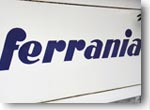
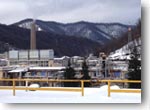
|
This report was initially written in german language and translated to english through a translation service company.
"THE FUTURE OF ANALOG FILM STARTS AGAIN FROM ITALY"
The call was surprising but not unexpected. The ongoing maintenance of our contacts with Marco Pagni, owner of Movie and Sound Firenze and co-founder of the new FilmFerrania, has all been about this. We have constantly wanted to buy machines for finishing and packaging films. We acquired one of our two high-speed Super 8 film slitters from Italy ( see article dated Dec. 06 2008). Marco Pagni made all the arrangements: negotiations, packaging, loading and video tutorials about operating the machine. Molto perfetto! |
The project that he now intends to realize together with his partner Nicola Baldini and a six-man team is incomparably larger than simply transporting a couple of machines from Point A to Point B. That was the reason for the call. "Does Wittner Cinetec want to help get our new color reversal film into the (small-format) box?" Absolutely, we would love to do that. The first part of FilmFerrania involves coating new film material in general. The final editing, packaging and marketing processes aside, this is a mammoth project. For this type of work, one is happy to have a strong partner who can do this work in industrial quality. We are quite proud that others are willing to involve us in the very early phases of such project development. Arranging the business plan and coating schedule as well as our dozen questions always results in a patient discussion-and-response session. We will do everything in our power to support this fantastic project. Viva Italia! Viva FilmFerrania!
|
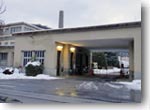
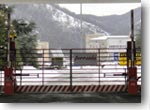 |
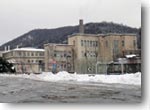
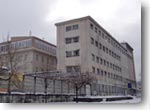
|
FilmFerrania is now using the former Research and Development Building of 3M/Ferrania Technologies. The facilities there were in use until just a few years ago and have been maintained. Of course despite this, or perhaps because of it, some maintenance and preparation work remains to be done. However, our pictures prove that a lot has been achieved already. Most of the equipment has been tested and made operational. In particular, "tons of money" were made in this location, when people were less limited in their investment options, until the Nineties. For that reason, the existing facility has been kept at the current state-of-the-art and was frequently improved through in-house developments. For example, in addition to all of the current computer control systems for all processes, important facility components were not made of steel but rather titanium, guaranteeing them an almost immortal life expectancy.
|
Bringing the facilities to life again is a dream for any technician; they have endured the years as if they had just been turned off after the last shift in large part. The initial impression was dominated by the existence of nearly limitless technical equipment while viewing the numerous halls and rooms. This picture shows the so-called R&D building, the home of the new FilmFerrania. The following pictures should have recorded our visit on Jan. 31 2014, along with their captions.
|
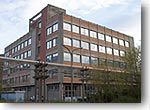
|
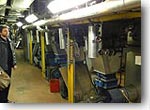
|
The powerful technology for controlling the climate and preparing water is located in the basement. Because the gigantic refrigeration system of the former Ferrania factory cannot be used for the relatively "small" production of the new FilmFerrania (it would like having an atomic power plant in the garden to run a night lamp), a so-called "chiller" was procured and installed for the new production facilities. This picture shows the distribution of the air conditioning system in the ventilation system for the individual work areas.
|
|
In addition to the climate control system, water preparation (technical water at various temperatures) is an important issue. In this picture, the system is being de-limed. Beer is not the only item brewed according the purity laws. The purity of the water used for film production plays a role that should not be underestimated. The coater's separate foundation, which is located above us on the first floor, is located on the same floor, even though it cannot be seen in the picture. The foundation has been cushioned against vibration from the rest of the building so that vibrations in the ground cannot be transferred to the layers of coated film. No one wants the applied emulsion to be wavy. No one!
|
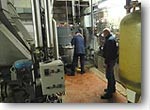
|
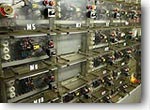
|
Moving along, we have a look at the numerous power sub-distribution units. It should be noted that in addition to the order and cleanliness this system is about contactors that are controlled from the control room. Or did you think that someone had to be here to operate the levers? Happily, these are only the main switches that do not have to be touched while in operation. Even here in the basement, we were able to learn that all of the technical processes can be remotely controlled by computers. The many years of investment in this area cannot be overlooked.
|
|
After water preparation (in process) and cooling (completed!), heating is however still missing. The driving force is steam. This is need for such banal things as heating the rooms as well as for "boiling" an entirely special soup: the so-called film emulsion, as well as for innumerable other technical processes. FilmFerrania must operate independently in this through the procurement of their own steam generation system. Nope, this is not a black cauldron fired by coal. But, it is similar with modern functionality using oil or gas, computer-controlled, of course.
|
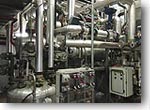
|
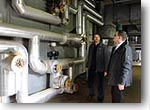
|
The Ferrania Research Building has benefited here from the existing infrastructure of a monstrous film factory in the earlier years - which has now been decommissioned. This means: no cold, no heat, no steam! The former power plant will temporarily be operated on the property and also supply steam to FilmFerrania during this time, however this is only temporary, for one thing, and for another at conditions that allow us to use the picture of coal being shoveled in another, purely figurative, context. Also, the energy lost through the existing steam pipes between the power plant and the FilmFerrania building is so large that generation of steam on site becomes unavoidable from the modern view of an energy- and cost-conscientious company. Here, Marco Pagni and Daniel Wittner are looking over the pipe(s).
|
|
In this picture, we are several floors higher (there are a total of five floors) in a dark room for test coatings. The device with the various holes accepts metal pans with sample emulsions and takes care of stirring them at exactly the right speed and temperature as appropriate for the respective emulsion. At the same time, Marco is explaining the advantages of titanium for certain components in contrast to other materials such as galvanic-coated metals.
|
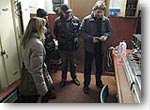
|
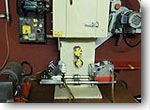
|
This is a coating machine. Yeah, well, it's a small one. The sample emulsions will spread to 110 mm wide and strips of roughly 2 meters using this equipment: a dip-coating process using a heated emulsion dip trough. Each layer of the new film material is being tested here until all of the parameters are exactly right. The large coating machine will only be used once they are right. After drying, these coated-film strips can be analyzed precisely. For this, several fully equipped labs are available for ensuring quality.
|
|
To prevent queues from forming for this dark room, there are identical dark rooms with coating machines all along the corridor, as far as the eye can see, as well as analysis rooms and emulsion "kitchens". We can't forget that we are in the development building of a one-time worldwide film production company. They have multiples of everything. Isn't that great?
This picture shows the drying cabinets, each with a different climate. The test strips rotate in these cabinets after coating until they are ready for analysis.
|
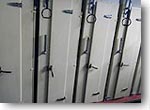
|
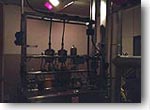
|
Here, we are peeking into one of the many small emulsion "kitchens". The red light was still on and it still smelled of all types of chemical substances. A new test had been in the process of being prepared. So, don't stick your finger in the pots. That might be dangerous. Since slightly volatile, poisonous or even highly flammable materials are often processed in these areas, special attention must be given to ventilation. Not just to protect the employees. Furthermore, electronic equipment (specially encapsulated motors, switches and pumps) has been designed to protect against explosions, or process controls (valves, agitators and so forth) are operated using compressed air in order minimize the possibility of electrical sparks.
|
|
The real, large-scale versions of everything modeled here can be found a couple rooms away or a couple of floors upon. "Large-scale" still means "small" on the industrial scale in comparison with the machines and quantities needed to "marry" the finished photographic emulsions. However for FilmFerrania, this "small-scale" represents the largest advantage that a photographic completion shop can offer today. Three thousand liters of emulsion can be prepared here, but doesn't have to be. Five, eight, eighteen or thirty liters of emulsion won't be lost in the pipes leading to the coating unit, because even the large coating machine has been designed to coat a wide roll, or a "mini-jumbo" as FilmFerrania employees like to call it, with a transparent quantity.
|
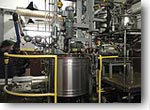
|
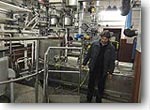
|
All process steps are monitored by a number of sensors even for manufacturing emulsions, which are compared against the specifications from the comprehensive computer monitoring system. For example, temperatures, agitator speeds, throughput quantities, pH values, pressures, filled levels, viscosity and fluidity are all constantly checked and logged. If an employee opens a valve manually, it will be noted. Each action will be recorded by the system in order to correct condition in the process chain if necessary or to be able to repeat them precisely if desired. The precision of this ability to reproduce such condition in the processes is key for a product with consistent photographic properties. "Creative" changes in the results through a lack of process control are not desirable in this case.
|
|
After touring through innumerable emulsion "kitchens" and the escaping the dark rooms to the sampling area, only reviewing the analysis rooms remains. With this X-ray spectrometer, the exact distribution of the silver salts can, for example, be determined in an emulsion. Worldwide, there are only a few example of this device with the required photo-technical equipment. This is one of them. Neither replacement parts nor service programs are available for it. For that reason, it is cherished and maintained and currently resides in the only permanently heated room, and it is given its TLC everyday.
|
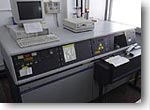
|
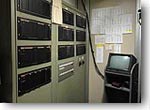
|
Was there something else? Oh, yeah. We almost forgot the king of the machines: the production coating machine. Allow us to introduce its Royal Majesty, the Big Coater. As initially noted, it sits on its throne on its own foundation and is connected to everything else that has occurred. Large sections of the building complex house the technology to provide this machine with everything that it needs in order to run. This king is very demanding. It needs warmth, cold, air whose temperature and humidity has been precisely conditioned, water, emulsion, power and the continuous attention of its technicians and this computer brain.
|
|
When all of the ingredients are right, at the right place and right time and all other parameters agree, this wonder of technology rewards its users with smooth slips of fed acetate or polyester film strips (23 cm wide, 750 meters long). This picture here shows the probably most exciting location in the FilmFerrania building. This is the part of the coating machine where all of the carefully prepared components come together: the booth for the operators, who (along with night vision equipment and infrared video monitors for the control room) watch as up to 8 coats simultaneously coat the film. The birthplace of film as we know it.
|
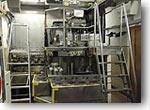
|
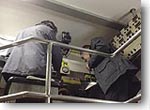
|
Marco Pagni is explaining the precise working process of this type of machine to Daniel Wittner. The pouring head is lifted hydraulically for coating, also called "dipping" in classic machine construction, and then moved to the film base after setup and inspection of the uninterrupted emulsion film. During this, all parameters are automatically recorded and corrections are made, if necessary. However like the emulsion technician, the operator requires a great deal of experience and feeling for the all of processes during and after the coating process. It is not without cause that FilmFerrania describes this as "the main assets of FilmFerrania are people" on their Internet site. The entire technology is useless without the knowledge and experience of the people entrusted with the operation of that technology.
|
|
Here again is a view of the heart of the facility: the coating head with 8 slits and 8 layers, when desired. In operation, it is hydraulically moved to the film base. There, it holds its waiting position before coating, or dipping. Emulsion coming from the head can drip down into a basin until the operator starts the coating process. The other two pictures show the unrolling and rolling equipment for the film base. In this case, we only see green leader film, which is drawn into the machine before and after each coating. One never wants to reset this, if it can be avoided. That would require a great deal of effort. Like the film roll in the coater, the rolling equipment has numerous sensors for quality assurance. One of them checks the regularity of the applied layer, one of Ferrania's custom developments. It takes advantage of the electric field and its interruption by the presence of resistance and thereby records a picture of the applied layer and its distribution.
|
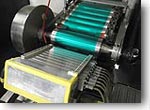
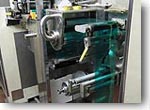
|
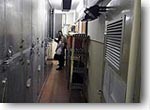
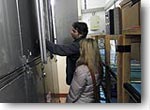
|
After the actual coating process, the film, coated with sticky, warm, wet emulsion, must first cool and dry once. To accomplish this, it goes through various climate zones in these drying cabinets, similar to the little stations for manufacturing samples noted earlier in this report. Of course, processing runs continuously and fully automated without outside action. The air pressure as well as humidity and temperature are checked because they play an important role in this. Thus, the film base side glides back and forth on an air cushion over the finely perforated guide plates in the dry cabinets. Thereby, the emulsion never touches a single element. The relatively compact construction of the drying step requires very precise maintenance of all air intake and exhaust parameters in order avoid endangering the film transport system or the curing process of the of the emulsion coatings. This is pure technology and expertise, which demonstrates the joy of FilmFerrania.
|
|
Marco Descalzo, General Manager of the Photo Color & Inkjet division of the former Ferrania Technologies, joins the party next to Marco Pagni and Nicola Baldini (right to left). Despite the contrariness of the weather and the lack of time in the FilmFerrania R&D schedule, we were able to tour the plant over several hours and have many, many interesting and valuable discussions. At this point, we would like to thank the entire FilmFerrania team for this once more. Italian hospitality, enthusiasm and the personal and professional motivation at FilmFerrania made a marvelous impression on us. Thank you very much!
|
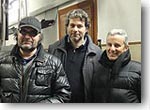
|
We now look forward with hope and optimism to the future of analog film and photography with many wonderful new film materials from Italy. As was noted at the beginning, we will support this intention with all of our power. We wish the entire FilmFerrania team the necessary patience and endurance for this wonderful project as well as rewarding and well-earned success in the future.
|
|
Additional Information:
You can find a report about our visit to the Kodak Super 8 factory here
You will find the types of film currently available for delivery in our online shop
Here you will find more information about FilmFerrania: www.filmferrania.it
|
| nach oben |
| |
 |
| |
| © Wittner Cinetec GmbH & Co. KG |
| |
|
x x x x x x x x x x x x x x x x x x x x x x x x x x x x x x x x x x x x x x x x |



























